SEO vs PPC: A Guide for B2B Technology Marketing
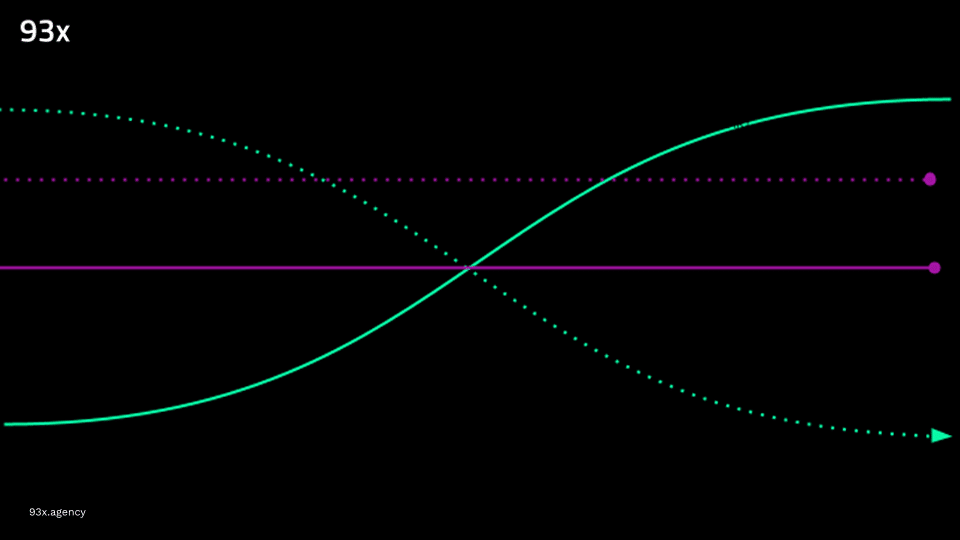
Introduction
SEO and PPC are two of the most well-known strategies for driving traffic, leads and new business for growing B2B technology companies. It’s no secret that both paid (PPC) and organic (SEO) strategies are key to a successful marketing strategy but how and when to use them can sometimes be difficult to decide.
In this article I’ll outline the importance of investing in both SEO and PPC as part of your digital marketing strategy, from the angle of a B2B SEO Agency and B2B PPC Agency. I’ll explain some of the common challenges faced by B2B tech marketers and hopefully by the end of this you’ll have a clearer understanding of how you can use paid search and search engine optimisation alongside each other to obtain a level of predictability in your lead generation numbers.
For the purpose of this article I’m going to focus mainly around Google Search and Google Ads. But the principles and strategies I’ll mention will apply to other platforms such as BING but i’m going to focus on Google as it’s the most widely used search engine in the world with around 75% market share.
Welcome to the Googleverse
Before I jump into talking about how to run these strategies on Google the first thing to remember is that Google is a business and a consumer product. That means it’s beholden to its shareholders and what it’s shareholders want are profits.
What this means is that the algorithms Google uses in both its search engine and its advertising platform are designed to increase usage. Increasing usage increases market value. The more people find Google useful, the more they use it and the bigger the audience there is to sell advertising space to (Google Ads).
It’s important to remember this because on SEO this means being as useful as you can possibly be and on Google Ads it’s worth remembering since Google has launched more automation into the tool which essentially will try and get you to spend more money in the long run.
More recently on Ads platform you’ll see lots of automatic recommendations about how you can increase conversions and improve performance, it’s worth taking these with a pinch of salt with the above in the mind and we will talk about how to train the algorithms to understand what’s valuable to you later on in this article.
SEO vs PPC: Which is better?
In a nutshell, SEO is a better strategy for B2B technology companies in the long-run but PPC can help bridge the gap while you’re waiting for your content to rank. This simplistic graph below is the best way for us to explain that for B2B lead generation in the long-run B2B SEO will always have a better ROI when you rank highly organically, but, it can take time to happen.
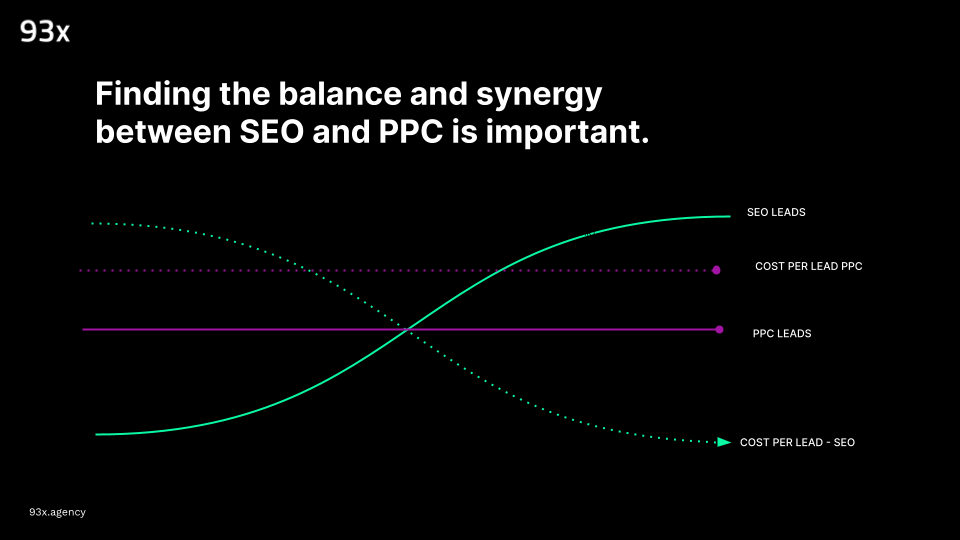
One of the main issues people have with this is that in a world based on data, you are reliant on a strategy that has no guarantees and can take some time to take effect. So the key here is to find the balance or the synergy between your SEO and PPC strategies so that you make sure you reduce your cost per lead in the long-run and eventually reduce your reliance on PPC for lead generation as it can be expensive in a lot of cases.
How to find the balance
The question then becomes how do you find the correct balance between SEO and PPC and how do you execute correctly on both of these strategies as it can be difficult to find results in one alone.
The first thing to get right for short term results is making sure you get your PPC campaigns up and running as efficiently as possible so that you’re not throwing money at Google.
Developing an efficient B2B PPC Strategy
To be able to have your PPC campaigns running in the background whilst you work on SEO you need have a reliable and efficient PPC campaign that you know will drive a certain number of leads each month. Efficiency is the key word here. What we mean by that is spending the right amount for the leads generated and not having the more money more leads approach – that comes later.
Why more ad spend doesn’t always mean more leads
One common misconception is that because PPC campaigns are all based around data and automation is that once you have a few leads come through you can simply invest more budget and see a larger return on investment. This may be the case when selling t-shirts but for B2B companies this is often not the case, especially when you work in a niche tech market and you’re trying to obtain higher value deals and search volumes are really low.
Split your ad spend by Inbound Funnel Stages
The greatest issue with B2B technology search is targeting the right users for high quality traffic. Often the search terms with the lowest volume produce the best quality leads. These are the long-tail searches as they are often called in the SEO world.
Most Google Ads / PPC accounts are themed around services / products, providing one budget for all keywords related to this service, this approach often leads to lower quality, high volume keywords taking the budget away from lower volume high intent keywords. This eventually leads to you throwing money at keywords that don’t convert and having really high cost per conversions.
There is one view here that some marketing teams have that if a new deal is worth £200k then spending £5k for a good lead is worth it, which logically makes sense but in reality when you are running these campaigns you’ll have a PPC account that is overpaying for everything and is less likely to appear in a search results. This is because a blanket approach means your quality scores are really low. A poor quality score can increase your cost per click by over 400% in some cases. Worth thinking about, especially if you want to spend your budget elsewhere.
To solve this problem you need to look at an intent based PPC budget structure that assigns most of your budget to keywords and searches that show real intent and only assigning a small portion to the more generic top of the funnel terms with low intent. For more information around the different B2B funnel stages have a read through this article we wrote about it.
Matching Keyword to Intent
To understand this concept a bit better we’ve used an example below to show you how different types of keywords can be mapped to the different stages of the funnel and therefore have different levels of intent.
The keywords below relate to a niche application lifecycle platform product that specialised in the medical and compliance space. As you can see the top of funnel keywords relate to broad topics such as “medical development” whereas the bottom of funnel keywords relate to much more specific high intent terms such as “ALM platform”.
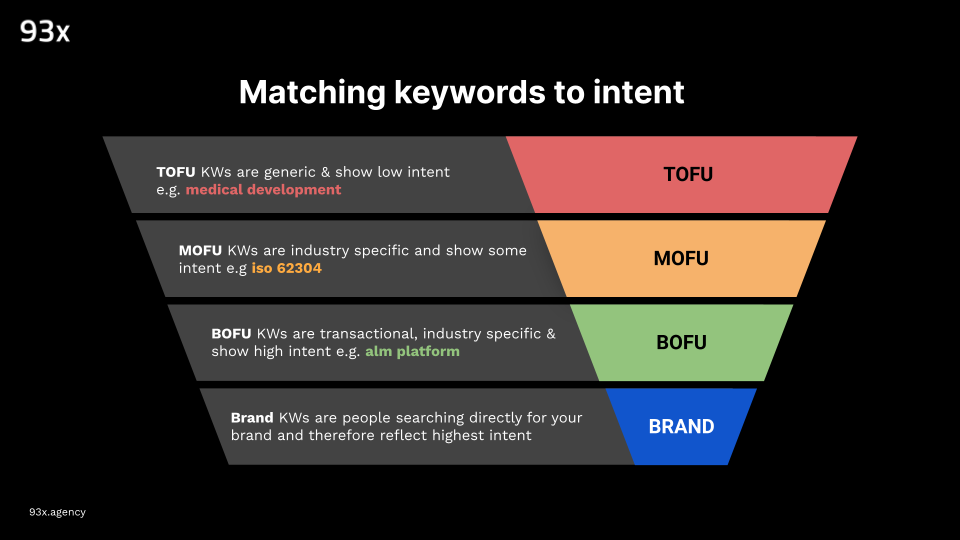
Another more common example of this could be a marketing automation platform such as HubSpot bidding on keywords like “Marketing automation” and “marketing automation software”. The latter keyword implies a higher level of intent to buy than the first and therefore is more likely to convert, so for PPC campaigns you want to invest more money in these terms.
Assigning relevant objectives at each stage
To be able to set-up your PPC campaigns correctly you’ll also need to have a clear objective for each one. Using this intent based PPC structure we can clearly map example objectives to each stage – as shown below.

Top of the funnel: Our objective is to discover new keyword opportunities and cast a wide-net to ensure we are always evolving the campaigns below.
Middle of funnel: Here we are looking to generate gated content downloads so form submissions usually on your website. These can be classified as top of funnel leads.
Bottom of funnel: At this stage the objective is generate qualified leads, people who are getting in touch about the product or service, or signing-up for a free trial.
Brand: It’s worth mentioning here that alongside the 3 above it’s worth protecting your branded search terms for some of the highest-intent buyers who may have already heard of you.
Intent Based PPC Bidding Strategies
Another big issue within B2B technology PPC campaigns is trying to optimise them when you have low conversion volumes and therefore limited data. Often users will not immediately fill out a contact us form, this makes it hard to understand which areas of the accounts are driving higher quality users that have a higher potential to convert.
One way we discovered to get over this issue is by using an intent based bidding structure where we assign values to different user behaviours that reflect different levels of user intent.
This is an example of some of the different actions you can use on a website to be able to break down that journey before someone actually fills in the contact form on a website.
In this scenario we assign a fictional value to the different conversion actions to train the computer to understand our business better and what we want it to focus on.

This allows the automated bid strategy to optimise towards producing as much value as possible within budget which ensures we’re investing in the highest intent users.
Scaling your PPC Campaigns
Once you have these foundations in place you can be more confident that you are feeding Google Ads with the correct data to be able to optimise your campaigns automatically. This means you can have more confidence in your campaigns and when it comes to investing more budget you will stand a better chance of getting a better ROI.
Investing in SEO in the meantime
Whilst you are laying the groundwork on your PPC campaigns and getting that in place you need to be investing in SEO as soon as possible. This is because of the lag between the work done and then seeing results. Sometimes you’ll only start to see results from an SEO campaign 3-6 months after the investment has been made, so it’s important not to delay on this front.
SEO as a specialism can really be grouped into three main streams of work: Technical, Links and Content. The technical aspects refer to the usability of your website, is it fast? Easy to use? Is it built to webmaster best practice guidelines? The linking part mainly focuses on which other reputable websites are building links to your website? These links are an important indicator of relevance. A link is like a vote of confidence from one website to another, and of course this helps Google determine how useful your website is.
The bit we focus the most for B2B SEO revolves around quality content. Content is the fuel for a successful website and long-term SEO campaign. Technical SEO is a one-off project a lot of the time and links often go hand-in-hand with content as that’s what people link to. So how do you go about it?
Producing content for SEO
The biggest mistake we see a lot B2B technology companies make in their SEO efforts is writing content about what they think is useful rather than what their potential buyers and users think is useful.
Google exists to provide users with the most relevant and reputable answers to their questions. Logic dictates here that if we can figure out what those questions are then we should be trying to answer them as best we can, better than anyone else, and in turn we’ll be rewarded. This is where using search data from keyword research & content research tools comes in handy.
High Investment in TOFU keywords
What this means in terms of where you are investing your money for SEO is that the majority of it goes into writing content that addresses questions at the top of the funnel. So unlike your PPC campaigns, the majority of your SEO campaign should focus around tofu keywords, so keywords that are more generic and relate to questions. We’ll explain why later.
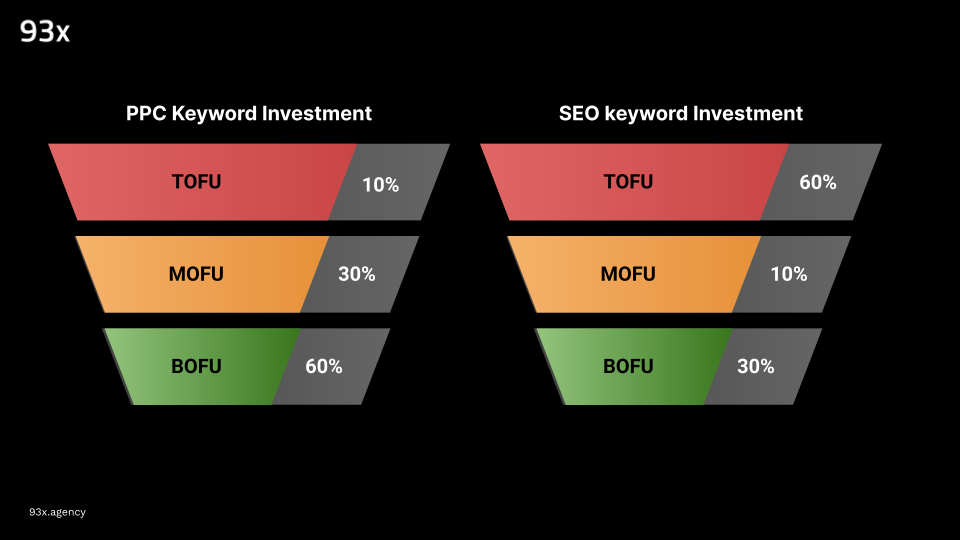
Mixing TOFU with MOFU content
At the top of the inbound marketing funnel you are aiming to produce content to attract new visitors to your website, this is what we are most interested in in regards to SEO.
What I mean here by mixing TOFU with MOFU content is that marketers are writing what they deem to be thought-leadership content on their blogs and then wondering why no-one reads it, lands on it or converts through it? At the top you are looking to educate users and in the middle and bottom it becomes more about persuasion – which is where thought leadership plays a bigger role.
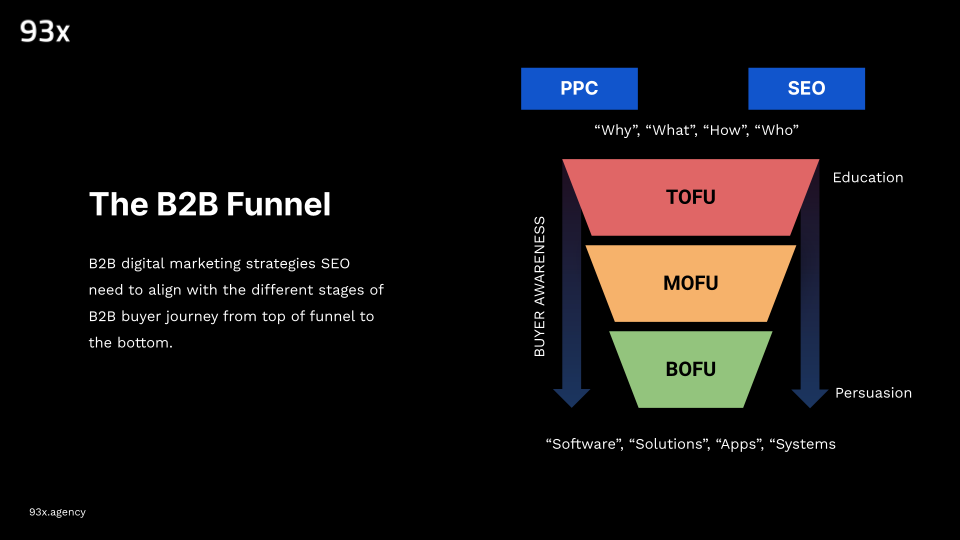
It comes down to the purpose of Google – Google is there to answer the world’s questions. So although content written to show how different and great your company is will help you close deals, it doesn’t really help people using Google.
This isn’t to say creating original thought-provoking content is a bad thing, of course it isn’t it, it sets you apart from the competition, it shows your level of knowledge in an industry and builds trust in your brand. The key is serving this content once a company has found you – not trying to get found with it.
Can’t content be both optimised for SEO and be thought leadership?
Yes. That comes down to quality of the content. Quality content will always rise to the top of a search result. If you focus solely on content that ranks but it’s basically clickbait this will not only hurt your companies reputation but it will also eventually may give way in the search results for someone who actually answers the question better.
To summarise that point, SEO is basically answering buyer questions on your website better than anyone else. Once you understand that you’re a servant of Google when it comes to attracting people to your website, the easier it is for you to generate the content that it wants.
Answering questions is just the start
Looping back around to look at buyer intent. Just like in the PPC campaigns you need to use an intent based framework for your SEO campaigns. Below is a simplistic diagram showing from left to right the buyer awareness stages and their level of intent to buy from you. What these means is that for SEO you need to produce content that addresses both low intent searches and high intent searches.

Why not just focus on high intent terms?
An obvious question here is why not just focus on search queries with high-intent. The reason for this is two fold. The first reason is that this is the most competitive market in terms of SEO and therefore the most difficult to see results. The second is that the pages you want to rank for these terms are usually short in word count and limited in terms of SEO – they are usually solutions or product pages.
The key to this is producing content that addresses the buyers problems at the low-intent stage and linking this content to the higher intent terms and pages. These are often referred to as topic clusters. A simple example is shown below referring to a company that sells AI demand forecasting software.
This plays into the role of Google, it will treat websites that are more “useful” with higher overall rankings, so answering questions around your services will have a knock-on effect on the page rankings for those highly competitive terms.
Simply put, if the search engine sees you are producing lots of useful content around a service it will then rank that service page higher for the really high intent terms.
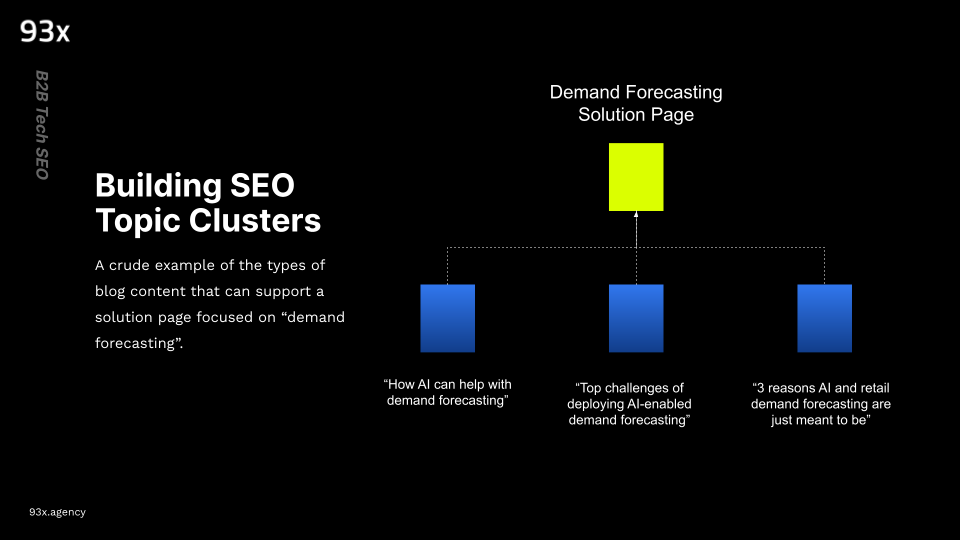
Combining your PPC & SEO Strategy
We’ve mentioned how you can run PPC and SEO campaigns for B2B technology companies and how the intent based approach works for each, but how do you find the balance and how does PPC affect SEO and visa versa?
PPC vs SEO for high intent keywords
Running the intent based PPC campaign structure we talked about earlier means that you put most of your budget into these high intent keywords further down the funnel. This is because it’s much harder to rank for these terms organically as they are the most competitive. They are also the most expensive when it comes down to cost per click.
You eventually may want to get to a point where you rank #1 for the term organically but then bid on it too. You are then owning potentially 40/50% of the screen view. Without trying to brag too much, below is an example of where we have achieved this. We rank #1 organically in this view and we have a PPC ad just above it, doubling our chances of gaining traffic and our exposure.
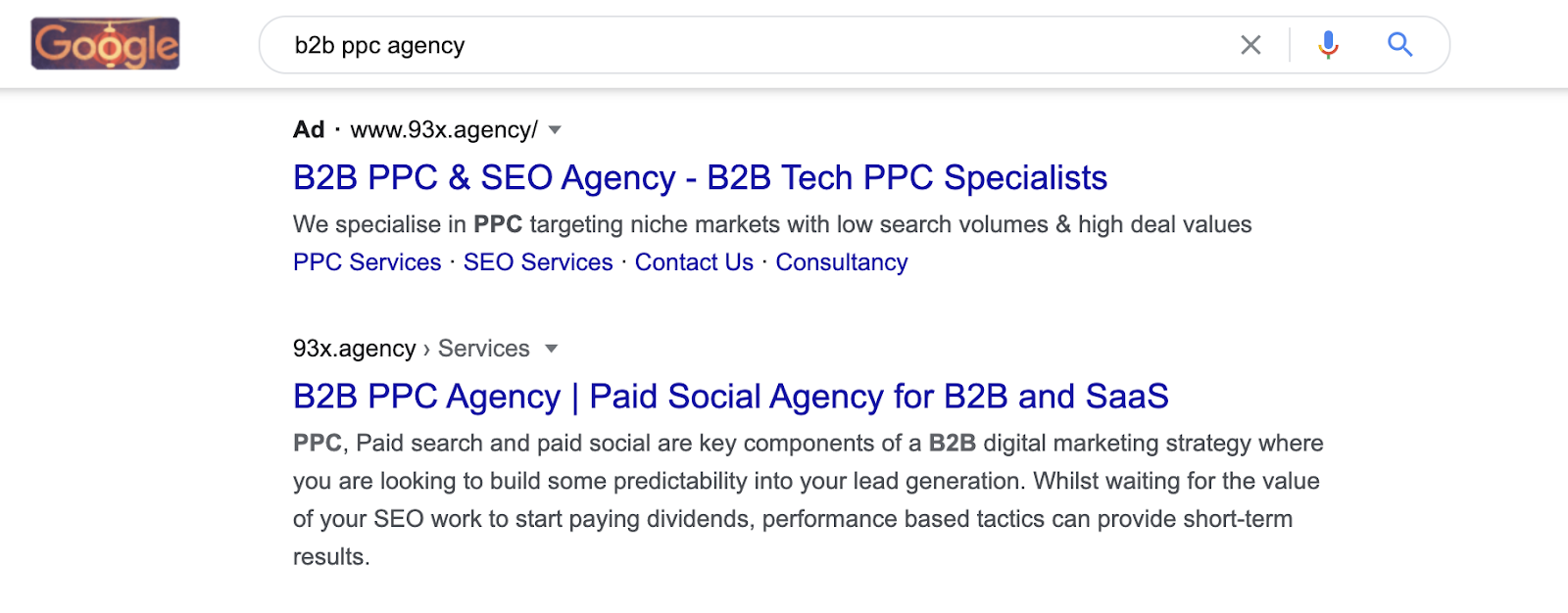
Does PPC affect SEO?
No. This is a common question but one that is easy to answer thanks to Google having been asked it a number of times, have a read through Google’s own response to this below, pretty clear I think.
“Ads are how we keep Search free and accessible to everyone. But ads are the only thing we sell.
We don’t charge anyone to appear in our search index. Whether a business, individual or organisation buys ads is not a factor in our search algorithms. We never provide special treatment to advertisers in how our search algorithms rank their websites, and nobody can pay us to do so.
Ads are only displayed if we believe that they’re relevant to the search terms you entered. For most searches, we show no ads at all. When we do show ads, they’re always labelled so that you can tell them apart from search results.”
An interesting take-away from this quote is the bit at the end “for most searches, we show no ads at all”. This goes back to Google trying to provide the most useful results. So when you are thinking about bidding on top of funnel search terms where people are searching for answers, your ad may not even get shown because it’s not relevant enough.
Monitoring SEO & PPC Performance
When it comes to comparing SEO vs PPC campaigns, you’ll need a way of reviewing progress and how to decide when you start to shift or reduce your spend in PPC or SEO.
One useful way of reviewing your organic and paid performance is to use a pre-built report inside of Google Ads called the Paid & Organic report. This report requires you to have linked your Google Search Console account to your Google Ads account before you can do anything with it.
Once connected together what this report allows you to do is compare directly your Google Ads Performance vs your Google Search performance.
You can spot where you are ranking organically and where you might be able to scale back PPC – you can also compare your click through rates for both paid and organic on the same keywords.
As you can see from the example screenshot below, you can see when only your ad is showing or where you are ranking organically too.
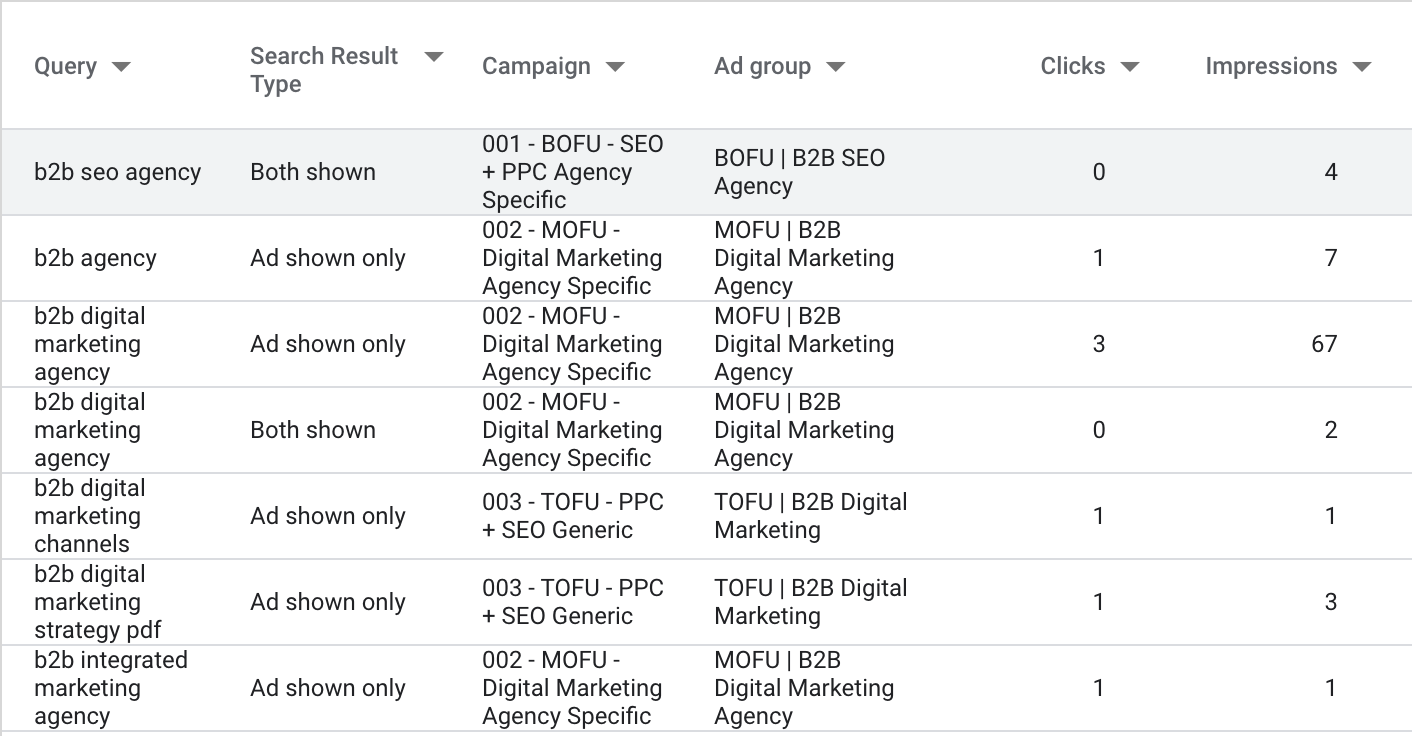
Summary
In summary if you are working in a B2B technology business trying to acquire high-value deals through inbound channels like SEO and PPC you need to move to an intent-based SEO and PPC strategy.
This means training the Google Ads algorithms by feeding it more data than it currently has and for SEO it means writing blog articles to answer the questions your buyers are asking online using keyword research.
It sounds simple but it can be tricky to put into practice and usually involves a lot of research around your buyer personas and their problems.
